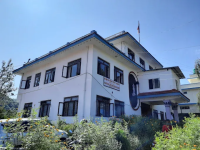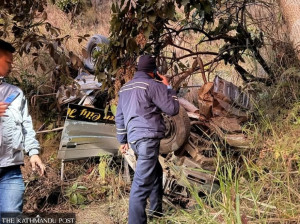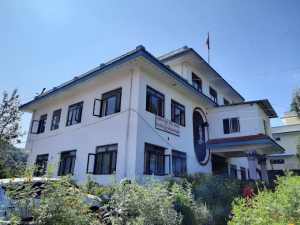Bagmati Province
Buffer zone area residents in Chitwan continue to get killed in human-animal conflict
Chitwan Park’s data shows 11 people were killed by wild animals in the area last fiscal year.
Ramesh Kumar Paudel
Until a year ago, Som Bahadur Bote, aged 63, lived in a tin-roof hut with his family at Meghauli of Bharatpur Metropolitan City-28 in Chitwan. Though flimsy in structure, the hut was usually lively with his wife, younger son, daughter-in-law and two grandchildren. The home wears a deserted look now.
Som Bahadur’s home lies at Andrauli, a few kilometres south from Jitpur Bazaar in Meghauli. There are around two dozen homes of the landless squatters at the border of Rapti Conservaton Buffer Zone Community Forest. Despite the Bote family working hard to eke out a living, Som Bahadur’s life went smoothly and happily.
But then, his life took a turn for the worse. On July 24, 2023, Som Bahadur’s son Aash Bahadur was killed in an attack of a tiger and his widow, Mina, died by suicide three months later.
“I was working near Jitpur Bazaar as a daily wage worker on that very day. It was at around 3pm. I was asked to come home at the earliest,” Som Bahadur recalled the tragic incident. “My neighbours took me towards the Rapti river that passes through Chitwan National Park. There I saw some people and army and police personnel. I was unaware till then why I was taken there. After crossing the river I was asked to identify a dead body—it was the body of my son.”
As per the record of the Cintwan National Park (CNP), the tiger mauled Aash, aged 26, to death while he was fishing in the Rapti river inside the national park. Som Bahadur could perform the last rites of his son after a long and arduous process to collect the body and conduct a postmortem.
“Mainly my wife and daughter-in-law were still traumatised and in deep mourning,” Som Bahadur said. “After Dashain, my wife wanted to visit our daughter’s house in Nawalparasi but the daughter-in-law did not want to go there. We went to the daughter’s house for a few days leaving the daughter-in-law and younger granddaughter.”
Once again, Som Bahadur was asked to rush home. His daughter-in-law had died by suicide.
“I had to perform 13-day death rituals of my son and daughter-in-law within three months,” Som Bahadur said. “The tiger killed my son and the bereaved daughter-in-law killed herself. Is there any bigger pain and suffering than losing a young son and daughter-in-law?”
As he could not raise and provide education to his grandchildren, Som Bahadur agreed to keep both the orphan granddaughters at the SOS children’s village in Bharatpur for their education.
The CNP, the country’s oldest national park, is the habitat of one-horn rhinos, Royal Bengal tigers, elephants and many more wild animals and birds. Many people, mainly the ones living in the buffer zone areas, are killed in human-animal conflict each year.
As per the data available at the CNP, 11 people were killed by wild animals in the area in the last fiscal year of 2023-24. “Five people died in the attack by rhinos while tigers mauled four people to death. Mugger crocodiles attacked and killed two people in the last fiscal year,” said Ganesh Prasad Tiwari, the information officer at the CNP.
The situation of 10 other victims and Aash Bahadur is different. The bereaved family of 10 other deceased received Rs1 million each. However, the impoverished family of Aash has been deprived of compensation.
As per the existing legal provisions, one will get compensation if the wild animals attack and injure or kill people in the buffer zone area. But the families of those killed inside the national park area cannot get compensation.
“The tiger mauled Aash Bahadur inside the national park boundary. There is not any legal provision to provide his family any compensation,” said Dil Bahadur Purja Pun, chief conservation officer at the CNP. According to him, the national human rights commission once asked me to provide compensation to Aash’s family. “The commission knew about the issue as the legal provisions do now allow us to provide compensation,” he added.
Som Bahadur is from the Bote community which traditionally ekes out a living by operating boats and fishing in the river and stream. He used to operate boats along with his father at Ghosarghat area in the Narayani river. “But people do not use boats to cross rivers nowadays. We don’t have other work. We work as daily earners in plantation and harvest seasons. How can we manage our livelihood?” said Som Bahadur. “Hotels sometimes call me to operate boats to move around tourists. But most of the time I cannot get any work.”
There are hundreds of families, mainly of the landless squatters, living near the national park. They go to the buffer zone community forests or sometimes to the national park forest for fishing and collecting fiddlehead ferns.
“My son was also with Aash Bahadur when the incident happened last year,” said Suka Bahadur Pariyar, neighbour of Som Bahadur. “They went to the area to collect niuro [fiddlehead fern]. They might have reached the national park area while searching niuro.”
According to the latest tiger census held in 2021, the tiger population in Nepal has reached 355. Among them, 128 tigers are in Chitwan National Park and its surrounding areas. Human-tiger conflict is unchecked in the area with the increasing number of the big cats.
According to the CNP, a total of 14 people were killed by tigers in the fiscal year 2021-22. The tiger-caused death was reduced to one in 2022-23. But the number increased to four the last fiscal year.




 5.44°C Kathmandu
5.44°C Kathmandu1.jpg)












